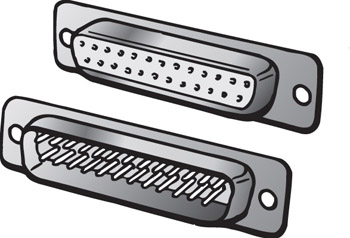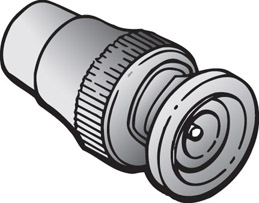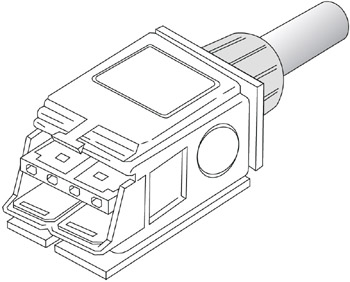Network Connectors
|
|
In addition to testing you on the various components you might find on a network, the Network+ exam will ask you to identify the types of connectors found on a network. When installing a network, you need to know which type of connector to use for which component. The type of connector you use depends on the type of network and the type of cable (copper or fiber-optic). In this section, we’ll discuss the connectors commonly used with copper cable:
-
D-type
-
BNC
-
RJ-series
-
IBM data
D-type Connectors
The first type of networking connector, the D-type connector, is used to connect many peripherals to a PC. A D-type connector is characterized by its shape. Turned on its side, a D-type connector looks like the letter D and contains rows of pins (male) or sockets (female). Figure 6.8 shows a male and female D-type connector.

Figure 6.8: A sample male and female D-type connector
| Note | D-type connectors are also called D-sub or DB connectors. |
The Attachment Unit Interface (AUI) connector used with the original DIX Ethernet implementation is a D-type connector and is included with many types of Ethernet NICs for compatibility. You can use an AUI connector with an external transceiver to change to a different media type (such as UTP to coax). To prevent the connector from disconnecting, two screws secure the male and female halves.
BNC Connectors
Most commonly used with coaxial cable, BNC connectors are tube-shaped, as Figure 6.9 shows. A twist-lock mechanism prevents the cable from disconnecting. You must push the cable’s connector onto the connector on the NIC and then twist the connector on the cable to lock it in place.

Figure 6.9: A sample BNC connector
BNC connectors are most commonly found in 10Base2 Ethernet networks, as well as in ARCnet, but they can be used on any network that is connected by coaxial cable.
| Note | The abbreviation for the BNC connector has been the topic of debate for years. Some people think that it is named after its developers (Bayonet, Neil, and Concelman). Others think the abbreviation comes from the description of the connector (Bayonet Nut Connector) or from its first use (British Naval Connector). |
RJ Connectors
You are probably familiar with the RJ (Registered Jack) family of connectors. The little clip connector at the end of the telephone cable that connects most home phones to the wall jack is an RJ-11 connector. RJ-45 connectors are most commonly found on both 10BaseT and Token Ring networks, but they can be found on any network that uses four-pair, UTP cable. Figure 6.10 shows an RJ-series connector. An RJ-11 connector is smaller than an RJ-45 connector and uses four (or six) wires; the RJ-45 has eight wires housed in its case. Figure 6.10 shows an RJ-45 connector that might be used in 10BaseT Ethernet.

Figure 6.10: A typical RJ-45 connector
| Tip | The RJ-45 is very popular, even outside networking. Frequently, this connector is used for digital phone systems in offices and motels. |
RJ-45 connectors use a small tab to lock the connector in place. Unfortunately, this tab, after many uses, can break. Fortunately, network connectors aren’t commonly connected and disconnected, so the instances of breakage are minimal. Plus, you can easily replace a connector by cutting off the old one and crimping on a new one.
The IBM Data Connector
The IBM data connector is unique in many ways. First, it isn’t as universal as the other types of network connectors. Second, there aren’t male and female versions, as with the others. The IBM data connector is both male and female. Any two data connectors can connect. This connector (shown in Figure 6.11) is most commonly used with IBM’s Token Ring technology and Type 1 or Type 2 STP cable.

Figure 6.11: An IBM data connector
The IBM data connector also uses a tab to hold the connectors together, but this tab is a little more rigid than the tab on the RJ-series connectors and doesn’t move as much. Therefore, breakage is not much of an issue.
The typical traveling office worker has a laptop and an analog modem. You just saw that an RJ-45 connector is similar to an RJ-11 connector, only wider. Yes, this means that an RJ-11 plug will make a perfect physical connection inside an RJ-45 jack. You also saw that this jack is used in many commercial phone systems. Connecting an analog modem (RJ-11 connector) to a digital system (RJ-45 jack) carrying a higher voltage, however, is never a pretty picture. One of two outcomes is possible:
-
The connection will not function.
-
The analog modem will never function again.
Clearly, when an analog device receives a digital signal, there is no basis for a successful connection. The second possibility arises when a higher voltage from the digital connection burns out the modem. Yes, I told you it could get ugly.
Additionally, some digital phone systems might also be using RJ-11 connectors and jacks. In this case, it is imperative that the jack be clearly labeled. If you’re on the road, pay careful attention to the type of wall jack you encounter.
|
|
- Challenging the Unpredictable: Changeable Order Management Systems
- ERP System Acquisition: A Process Model and Results From an Austrian Survey
- Enterprise Application Integration: New Solutions for a Solved Problem or a Challenging Research Field?
- The Effects of an Enterprise Resource Planning System (ERP) Implementation on Job Characteristics – A Study using the Hackman and Oldham Job Characteristics Model
- Intrinsic and Contextual Data Quality: The Effect of Media and Personal Involvement